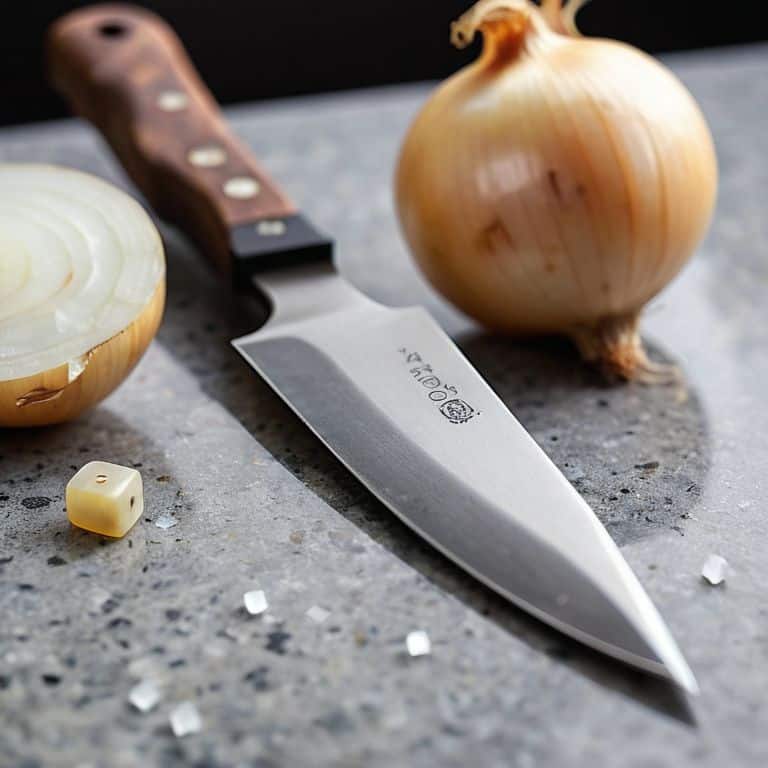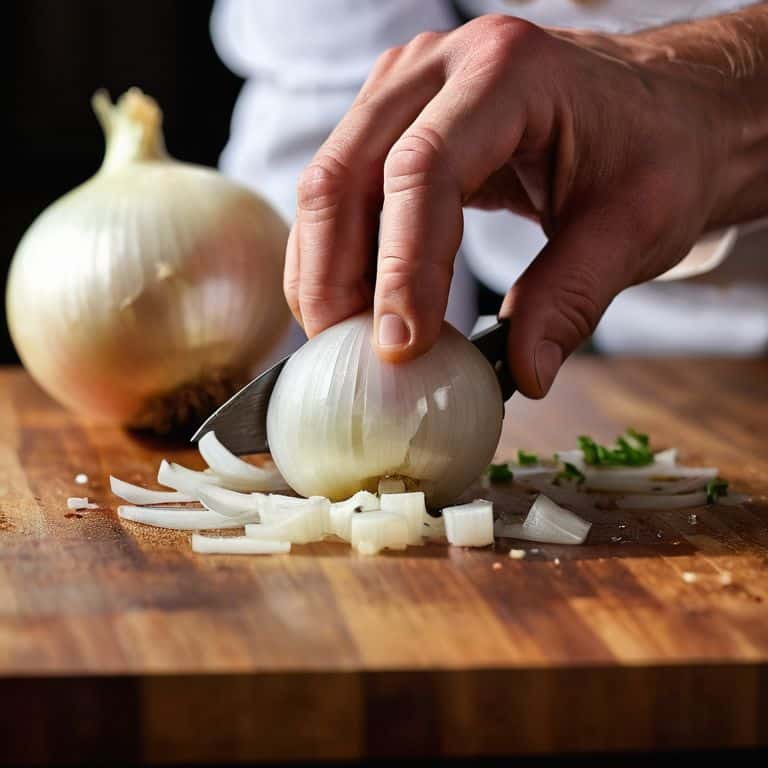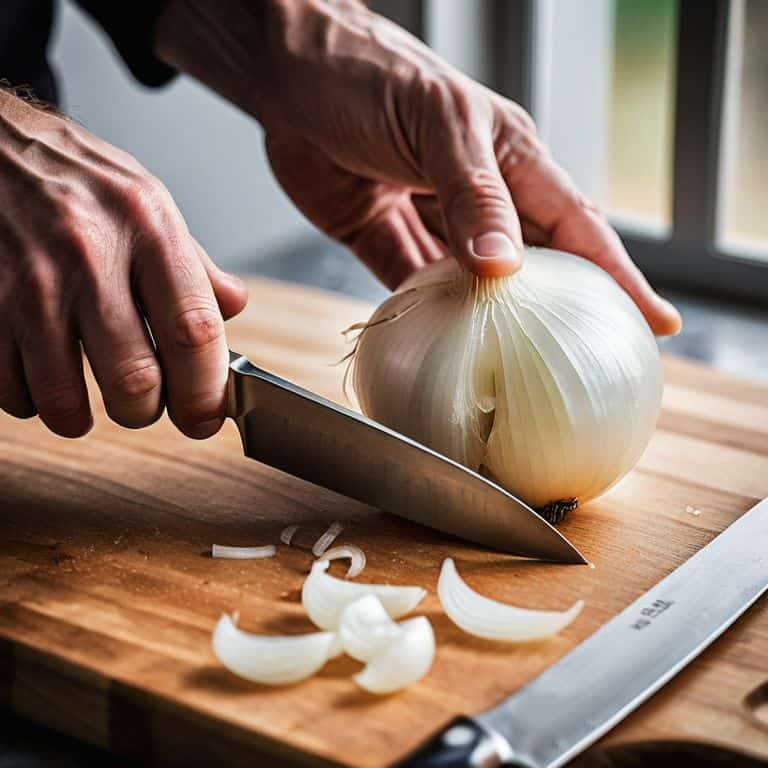As a flight instructor, I’ve learned that precision and patience are key to mastering any complex task, even something as mundane as how to dice an onion. I still remember my first flight student, who was so nervous that he couldn’t even chop an onion for our post-flight meal without tearing up. It got me thinking – if we can break down the fundamentals of flying into simple, manageable steps, why not apply the same principle to everyday tasks like cooking? That’s why I’m excited to share my guide on how to dice an onion, a crucial skill that can elevate any dish from bland to grand.
In this article, I promise to walk you through a step-by-step process that will make you a pro at dicing onions in no time. You’ll learn how to choose the right onion, prepare your tools, and execute a flawless dicing technique. My goal is to provide you with honest, no-hype advice that you can apply in your own kitchen, without any fancy gadgets or culinary degrees. By the end of this guide, you’ll be able to dice an onion with confidence and ease, and maybe even appreciate the therapeutic benefits of cooking, just like I do after a long flight.
Table of Contents
Guide Overview: What You'll Need

Total Time: 5 minutes
Estimated Cost: No cost, using existing kitchen tools
Difficulty Level: Easy
Tools Required
- Sharp Chef Knife (with a straight or curved blade)
- Cutting Board (preferably made of wood or plastic)
Supplies & Materials
- Onion (any variety)
- Paper Towels (for drying hands)
Step-by-Step Instructions
- 1. First, let’s start by preparing our workstation, just like a pre-flight checklist. Make sure you have a clean, stable surface to work on, and all the necessary tools are within reach, including a sharp knife, a cutting board, and the onion itself. This will help you stay focused and avoid any accidents.
- 2. Next, we need to peel the onion, removing the outer layer to expose the inner flesh. This is similar to removing the cover of an aircraft engine to access the internal components. Be careful not to tear the onion’s layers as you peel, as this can make the dicing process more difficult.
- 3. Now, we’ll align the onion on the cutting board, ensuring it’s stable and secure. Just as a pilot needs to align the aircraft with the runway for a safe landing, we need to position the onion correctly for safe and efficient dicing. Locate the root end of the onion, which will serve as our reference point.
- 4. With the onion aligned, we’ll make our first cut, parallel to the cutting board, about halfway through the onion. This cut will help us create a stable base for further dicing. Think of this step as setting the flaps on an aircraft – it prepares us for the next phase of the process.
- 5. Next, we’ll make a series of perpendicular cuts, starting from the root end and moving towards the opposite end of the onion. These cuts should be evenly spaced and about the same depth as the first cut. This process is similar to navigating through a series of waypoints – each cut brings us closer to our destination, which is a perfectly diced onion.
- 6. Now, we’ll turn the onion 90 degrees and make another series of cuts, intersecting the previous ones, to create our dice. This step is crucial, as it requires precision and attention to detail, much like the final approach in an aircraft landing. Take your time and ensure each cut is accurate and consistent.
- 7. Finally, we’ll gather and inspect our dice, just as a pilot reviews the aircraft’s systems after landing. Check for any uneven pieces or remaining larger chunks, and make adjustments as needed. This final step is essential to ensure our diced onion is ready for use in any recipe, and it’s a great opportunity to practice our attention to detail.
Mastering Onion Dicing

As we delve deeper into the world of onion dicing, it’s essential to master a few onion chopping techniques that will make your salad preparation a breeze. One of the most critical aspects of dicing onions is using the best knife for dicing onions, which is typically a sharp, thin-bladed knife. This will help you make precise cuts and prevent the onion from tearing.
When it comes to preventing onion tears, there are a few tricks you can use to minimize the irritation. One method is to chill the onion in the refrigerator for about 30 minutes before dicing, which will help to reduce the amount of gas released. Another technique is to dice the onion under cold running water or with a fan blowing towards your face, as this will help to dissipate the gas away from your eyes.
By mastering these basic knife skills for beginners, you’ll be well on your way to becoming an onion dicing pro. Remember to always use a gentle, rocking motion when making cuts, and to keep your knife sharp. With practice, you’ll be able to dice onions quickly and efficiently, making it a valuable addition to your onion preparation methods. Whether you’re making a salad or cooking a stir-fry, having this skill under your belt will save you time and frustration in the kitchen.
Best Knives for Tear Free Dicing
When it comes to tear-free dicing, the right knife can make all the difference. As a flight instructor, I always emphasize the importance of having the right tools for the job. In the kitchen, a sharp, high-carbon stainless steel knife is your best copilot. Look for one with a straight or slightly curved edge, as these are ideal for making smooth, even cuts through the onion’s layers. A good knife will help you maintain control and precision, much like how a well-tuned aircraft responds to its pilot’s inputs.
I recommend a knife with a comfortable, balanced feel in your hand, allowing you to make precise cuts with ease. Some of my students prefer a chef’s knife, while others swear by a paring knife. Ultimately, the best knife for tear-free dicing is one that feels like an extension of your own hand, allowing you to focus on the task at hand and slice through the onion with confidence.
Onion Chopping Techniques Explored
As we delve deeper into the world of onion dicing, it’s essential to explore various chopping techniques. Just like navigating through different flight conditions, adapting your chopping method can make all the difference. I recommend starting with a gentle, rocking motion, applying even pressure to ensure uniform cuts. This approach helps prevent tearing and promotes a clean, crisp texture.
By mastering these techniques, you’ll be able to tackle even the most stubborn onions with confidence. Remember, practice makes perfect, so don’t be discouraged if it takes a few attempts to get the hang of it. With patience and persistence, you’ll be dicing like a pro in no time, and your dishes will take on a whole new level of flavor and texture.
Flying Through Onion Dicing: 5 Key Tips to Soar

- Understand your aircraft, or in this case, your knife: choosing the right tool for the job can make all the difference in smooth, tear-free onion dicing
- Pre-flight checks are essential: ensure your onion is properly secured and your cutting board is clear of any obstacles
- Master the art of layer management: just as navigating through different air traffic control zones requires precision, dicing an onion requires careful consideration of each layer
- Maintain a steady hand and calm mindset: the key to avoiding turbulence in onion dicing is to remain focused and methodical in your approach
- Review and adapt: just as a pilot must review flight plans and adapt to changing weather conditions, you should continuously evaluate and refine your onion dicing technique for optimal results
Key Takeaways for Mastering Onion Dicing
Dicing an onion efficiently requires a combination of the right knife, a stable cutting board, and a systematic approach to layering and cutting, much like how a pilot must consider multiple factors before takeoff
Selecting the best knife for the job, such as a sharp chef’s knife, can significantly reduce tear production and improve the overall dicing experience, similar to how the right aircraft equipment can enhance flight safety and performance
Practicing various onion chopping techniques and understanding how different cuts affect the final product can elevate your cooking skills, just as continuous training and learning about aviation fundamentals can make a better pilot, highlighting the importance of patience, practice, and dedication in both cooking and flying
Navigating the Skies of Culinary Delights
Just as a steady hand and a clear mind are crucial for a smooth takeoff, dicing an onion requires patience, precision, and practice – the turbulence of tears is just a minor setback on the journey to culinary mastery.
Daniel Sato
Landing Safely: A Conclusion to Mastering Onion Dicing
As we touch down on our journey to mastering the art of dicing an onion, let’s do a quick preflight check of the key points we’ve covered. We started with a simple, step-by-step guide on how to dice an onion, breaking down the process into manageable chunks, just like I do with my flight students when we’re learning complex maneuvers. We then explored various onion chopping techniques, discussing the best methods for achieving uniform pieces and minimizing waste. Finally, we examined the importance of using the right tools for the job, including the best knives for tear-free dicing.
As you continue on your culinary journey, remember that practice makes perfect. Don’t be discouraged if your first few attempts at dicing an onion don’t turn out exactly as you hoped – with time and patience, you’ll be slicing like a pro. And when you are, take a moment to appreciate the simple joys of cooking, just as I do when I’m soaring through the skies or hiking through the backcountry. The fundamentals of flight and the fundamentals of cooking may seem like vastly different things, but at their core, they both require patience, attention to detail, and a passion for the journey.
Frequently Asked Questions
What is the safest way to handle a knife when dicing an onion to avoid accidents?
When handling a knife for onion dicing, remember to grip it firmly, but not overly tight, with a controlled motion. Keep your fingers curled under and out of the blade’s path, just like you’d keep your wings level during turbulence. A smooth, gentle touch is key to safe and accident-free dicing.
How do I prevent my eyes from watering while dicing an onion?
To prevent watery eyes, try chilling the onion in the fridge for 30 minutes before dicing. This reduces the sulfur compounds that cause irritation. You can also dice under a vent or with a fan blowing away from you, just like how airflow helps disperse fog on a runway, it can help here too.
Are there any specific onion varieties that are easier to dice than others?
When it comes to dicing onions, some varieties are indeed easier to work with than others. I’ve found that sweeter onions like Vidalia or Maui tend to have a lower water content, making them less prone to tearing and easier to dice. It’s a bit like flying a plane with a smoother airframe – it just makes the whole process more enjoyable!
